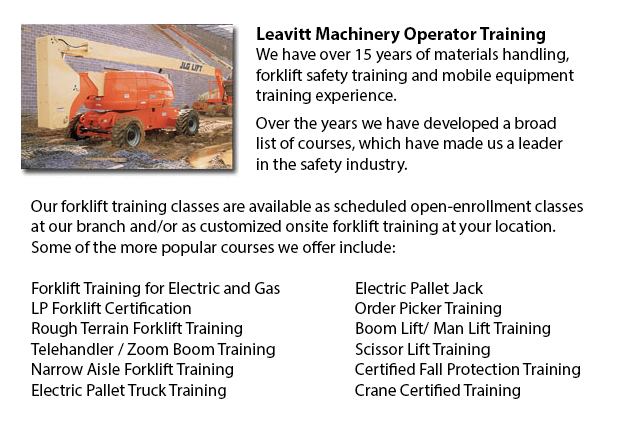
Ontario Aerial Lift Safety Training - There are around 26 to 30 construction deaths within North America due to the utilization of aerial lifts. Most of those killed are craftsmen such as painters, electrical workers, laborers, carpenters or ironworkers. The majority of the deaths are caused by electrocutions, falls and tip-overs. The greatest danger is from boom-supported lifts, like cherry pickers and bucket trucks. The majority of the fatalities are related to this type of lift, with the rest involving scissor lifts. Other risks include being thrown out of a bucket, being struck by falling objects, and being caught between the lift bucket or guardrail and an object, like for example a joist or steel beam.
The safe operation of an aerial lift needs a check on the following items before utilizing the device: emergency and operating controls, personal fall protection gear, safety devices, and tires and wheels. Check for possible leaks in the air, fuel-system, hydraulic fluid. Check the device for missing or loose parts.
The location where the device will be utilized should be carefully checked for potential hazards, like bumps, holes, debris and drop-offs. Overhead power lines should be closely monitored or avoided. It is recommended that aerial lift devices be utilized on surfaces that are level and stable. Don't work on steep slopes that exceed slope restrictions specified by the manufacturer. Even on a level slope, wheel chocks, outriggers and brakes should be set.
Companies must provide their aerial lift operators with the correct guidebooks. Operators and mechanics should be trained by a certified person experienced with the relevant aerial lift model.
Aerial Lift Safety Guidelines:
o Before operating, close doors and lift platform chains.
o Leaning over and climbing on guardrails is prohibited. Stand on the platform or floor of the bucket.
o Stay within manufacturer's load-capacity limitations.
o When working near traffic, use appropriate work-zone warnings, like for example cones and signs.
If correct procedures are followed, electrocutions are avoidable. Stay at least ten feet away from whichever power lines and certified electricians should insulate and/or de-energize power lines. Individuals working must use personal protective tools and equipment, such as a bucket that is insulated. Nevertheless, a bucket that is insulated does not protect from electrocution if, for instance, the individual working touches a different wire providing a path to the ground.
When inside the bucket, workers have to prevent possible falls by securing themselves to the guardrails by using a full-body harness or a positioning device. If there is an anchorage inside the bucket, a positioning belt with a short lanyard is adequate.
Tip-overs are preventable by following the manufacturer's instructions. Unless the manufacturer specifies otherwise, never drive when the lift platform is elevated. Follow the device's horizontal and vertical reach limitations, and never exceed the load-capacity which is specified.
-
Ontario Manlift Certification
Ontario Manlift Certification - The Elevated Platforms and Manlifts Certification course helps to provide the required training on the work practices, safe operating procedures, regulations and rules regarding the everyday activities for the operator... More -
Ontario Crane Training
Ontario Crane Training - Bridge cranes or overhead cranes are actually a type of industrial material handling crane making use of a line and hook mechanism that runs on a horizontal beam running along two widely separated rails. Various overhead cran... More -
Ontario Aerial Lift Train the Trainer
Ontario Aerial Lift Train the Trainer - The Aerial Lifts Train the Trainer Certification Program teaches trainers how to effectively train operators in safe industrial mobile machinery operation. Trainers are given in-depth instruction about aerial l... More -
Ontario Warehouse Forklift Training Classes
Ontario Warehouse Forklift Training Classes - The reason for warehouse training classes are to raise the awareness of common workplace dangers. The trainees will learn essential warehouse safety procedures. An emphasis is placed on paying attention t... More -
Ontario Forklift Training School
Ontario Forklift Training School - Forklift Training School - Industry and federal regulators have established the criteria for forklift safety training based on their current standards and regulations. Those wanting to operate a forklift must finish... More -
Skid Steer Loader Training in Ontario
The engine powered skid-steer loader consists of a rigid and small frame, equipped along with lift arms that could attach to lots of industrial tools and attachments to execute many labor saving jobs. Normally, skid-steer loaders are four-wheel drive... More -
Ontario Crane License
Ontario Crane License - Crane operators ought to be "credentialed", that means they ought to own a crane operator certification or license. Credentialing is considered a mandatory governmental requirement to be able to practice as an operator of a cr... More -
Ontario Forklift Operator Training
Ontario Forklift Operator Training - Forklift training is a prerequisite in North America and is intended to prevent workplace injuries and death. Forklift training offers driver training intended for forklift operators. Training programs teach the s... More

Forklift Certification Ontario
TOLL FREE: 1-888-254-6157
Toronto, Ontario
forkliftcertificationontario.com
Email Us
About Us


